
- Israeli Air Force planes struck Iranian military targets and nuclear facilities on Thursday.
- Israel’s F-35I stealth fighter jets participated in the strikes targeting Iran’s nuclear program.
- The planes also aided defenses against Iranian missiles in 2023 and 2024.
Israel carried out a preemptive strike on Iran’s nuclear facilities on Thursday, deploying its fleet of F-35I stealth fighter jets for the mission.
The F-35I, dubbed “Adir” or “Mighty One” in Hebrew, is a specially modified version of the U.S.-built Lockheed Martin Lightning II Joint Strike Fighter. Known for its superior stealth and enhanced electronic warfare systems, it stands as a key component of Israel’s aerial defense capabilities.
Alongside the strike on Iran, Israeli forces also used these jets to intercept a missile launched in 2023 by a Yemeni group backed by Iran, and to neutralize hundreds of drones, missiles, and rockets during Iran’s retaliatory assault in 2024, according to the Israel Defense Forces.
Here’s a closer look at the “Mighty One” military aircraft.
F-35 Lightning II stealth fighter jets, produced by Lockheed Martin, are some of the most advanced military aircraft in the world.
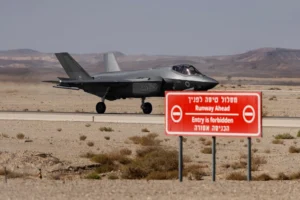
The F-35 carries its weapons and fuel inside the aircraft, and its carefully aligned surfaces along with radar-absorbing materials help it avoid detection. According to a January report by The National Interest, operating the jet costs around $44,000 per hour.
Equipped with cutting-edge stealth technology and powerful data-processing systems, the F-35 is also capable of reaching supersonic speeds up to Mach 1.6, equivalent to 548.8 meters per second.

In 2018, Lockheed Martin CEO Marillyn A. Hewson stated that the aircraft can operate in what’s referred to as “beast mode,” allowing it to carry as much as 18,000 pounds of both internal and external weapons, including munitions weighing up to 5,000 pounds.
In 2016, Israel became the first country other than the US to acquire F-35 fighter jets.
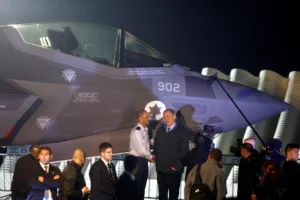
Israel was the first nation to acquire the aircraft through the U.S. Foreign Military Sales program, purchasing 50 jets, according to Lockheed Martin. The country has also introduced extensive customizations to the planes.

Israel produces its own wings and electronic warfare systems for the F-35I and has created a customized version of the advanced helmet, which projects critical data—such as airspeed, altitude, and targeting details—onto the pilot’s visor. The Israeli Air Force has named this F-35I model “Adir,” which translates to “Mighty One” in Hebrew.

The Israeli Air Force incorporated the six-pointed Star of David—a prominent Jewish symbol also featured on the nation’s flag—into the jet’s design. In 2018, according to the air force chief, Israel became the first country to deploy the F-35I in combat operations.

“We are flying the F-35 all over the Middle East and have already attacked twice on two different fronts,” then-Israeli Air Force chief Major-General Amikam Norkin said in a speech at a gathering of foreign air force leaders, Reuters reported.
In July 2023, Israel acquired an additional 25 Adir planes in a $3 billion deal.
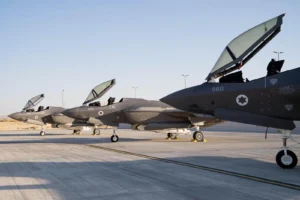
According to Reuters, the purchase was funded through U.S. military aid provided to Israel. In November 2023, the Israel Defense Forces (IDF) reported that its F-35I Adir fighter jets intercepted a missile launched by an Iran-aligned group in Yemen.
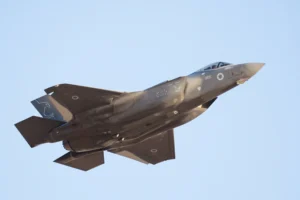
This marked the first documented instance of a cruise missile being intercepted by an F-35 aircraft.
The Israeli Air Force shared video footage of the event on X, stating in Hebrew that its forces are “constantly engaged in planning and managing defense operations, ready to respond to any threat in any region.”
In April 2024, Iran appeared to target the Nevatim Air Base — home to Israel’s F-35I fleet — during an assault.

Iran and its proxies in Iraq, Yemen, and Lebanon launched over 350 ballistic missiles, cruise missiles, and drones at Israel, but about 99% were intercepted by Israeli forces and their allies. According to the IDF, only a small number made impact, causing minor damage near a runway at Nevatim Airbase and on a road in the Hermon region.
The missiles appeared aimed at Israel’s Nevatim Airbase in the Negev Desert, home to its F-35I stealth fighters. Despite the assault, the base remained fully operational, with Adir jets actively contributing to the defensive response, according to the IDF.
“Iran hoped to cripple the base and weaken our aerial strength, but it did not succeed,” said IDF spokesperson Rear Adm. Daniel Hagari.
On Thursday, the Israeli Air Force deployed more than 200 fighter jets—including F-35Is—in a preemptive strike on Iran’s nuclear facilities.
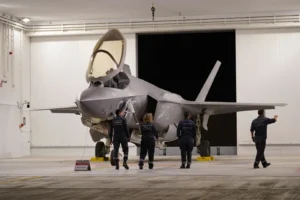
An IDF spokesperson stated that Israeli fighter jets carried out strikes on more than 100 locations across Iran on Thursday, aiming to prevent the country from acquiring nuclear weapons. Targets included military facilities and Iran’s main uranium enrichment site in Natanz.
According to the IDF, Iran’s nuclear efforts have “advanced rapidly” in recent months, which it described as “clear proof that the Iranian regime is pursuing a nuclear weapon.” Iran, however, insists its nuclear program is intended solely for peaceful, civilian use.
“This mission is vital to counter a threat to our existence posed by an enemy determined to destroy us,” said Lt. Gen. Eyal Zamir, Chief of the General Staff of the IDF.
The IDF also released images of aircraft involved in the wide-ranging mission, including F-35I fighter jets.
In response, Iran launched over 100 drones early Friday morning, the majority of which were intercepted by Israeli air defenses, according to the IDF.
Meanwhile, the war in Gaza has reignited debate over U.S. military support for Israel.
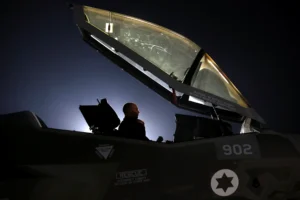
The October 7 attacks by Hamas resulted in the deaths of approximately 1,200 Israelis and the abduction of over 240 individuals. An estimated 53 hostages are still held in Gaza, though their current status remains unclear.
In response, Israel launched a military campaign in Gaza that has led to more than 55,000 Palestinian deaths, according to figures from Gaza’s Hamas-run Health Ministry, cited by the UN Office for the Coordination of Humanitarian Affairs. The Israel Defense Forces claim that around 17,000 of those killed were Hamas fighters.
The United Nations Relief and Works Agency reports that the conflict has displaced over 1.9 million people in Gaza—roughly 90% of the territory’s population.
The immense human suffering caused by the war, particularly involving U.S.-supplied aircraft like the F-35I, has sparked renewed debate in the U.S. about its military assistance to Israel, with some members of Congress calling for potential conditions on aid.











